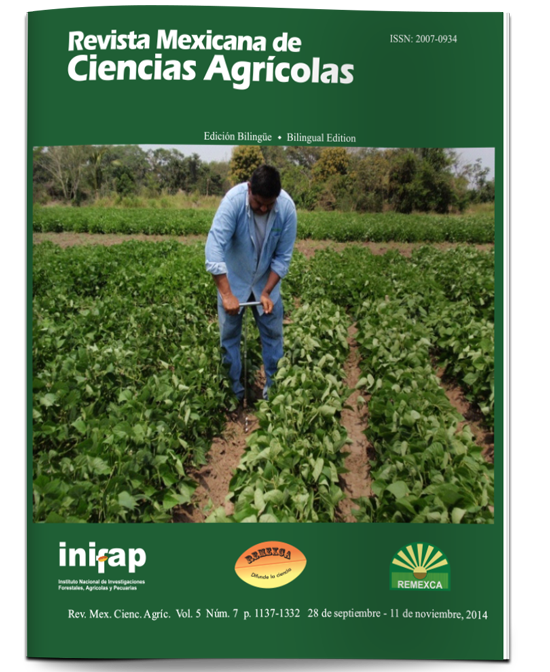Opaque Negro bean genotypes resistant to terminal drought
DOI:
https://doi.org/10.29312/remexca.v5i7.866Keywords:
Phaseolus vulgaris L., terminal water stress, genetic resistance, selectionAbstract
In Veracruz, terminal drought is the most limiting abiotic feature for the production of beans (Phaseolus vulgaris L.) in the production system of residual moisture. The objectives of the research were: to rated opaque Negro bean genotypes for resistance to drought and to identify the most efficient yield under irrigated and terminal drought in winter-spring 2013, two experiments were conducted Cotaxtla, Vieracruz; one with full irrigation and other irrigation suspension from the start of flowering. 22 lines and varieties Negro INIFAP, Negro Tacaná and Negro Jamapa were evaluated in randomized block experimental design with three replications. Days at physiological maturity were quantified, dry matter production without grain, pods per plant, seeds per pod, 100 seed weight and grain yield. As estimators of efficiency indices drought susceptibility (ISS) and relative efficiency yield (IER) were used. Yield and the number of pods per plant were the most affected characteristics by terminal drought, with average reductions of 41.39 and , NCB-229, SCN-2, Jamapa Plus and SEN-70 were the most resistant genotypes to drought, whereas X02-33-159-2, X02-33-147-2, B 98311, MBSF-14729 and Negro Jamapa, the most susceptible. CIAT-103-25, SCN 2 SEN 70, NGO 229, 17-99 and NCB 229 showed the best efficiency in irrigation and drought yield (IER greater than 1.35) while X02-33-159-2, B-98311, MBSF-14729 and Negro Jamapa, had the lowest production efficiency.
Downloads
Downloads
Published
How to Cite
Issue
Section
License
The authors who publish in Revista Mexicana de Ciencias Agrícolas accept the following conditions:
In accordance with copyright laws, Revista Mexicana de Ciencias Agrícolas recognizes and respects the authors’ moral right and ownership of property rights which will be transferred to the journal for dissemination in open access. Invariably, all the authors have to sign a letter of transfer of property rights and of originality of the article to Instituto Nacional de Investigaciones Forestales, Agrícolas y Pecuarias (INIFAP) [National Institute of Forestry, Agricultural and Livestock Research]. The author(s) must pay a fee for the reception of articles before proceeding to editorial review.
All the texts published by Revista Mexicana de Ciencias Agrícolas —with no exception— are distributed under a Creative Commons License Attribution-NonCommercial 4.0 International (CC BY-NC 4.0), which allows third parties to use the publication as long as the work’s authorship and its first publication in this journal are mentioned.
The author(s) can enter into independent and additional contractual agreements for the nonexclusive distribution of the version of the article published in Revista Mexicana de Ciencias Agrícolas (for example include it into an institutional repository or publish it in a book) as long as it is clearly and explicitly indicated that the work was published for the first time in Revista Mexicana de Ciencias Agrícolas.
For all the above, the authors shall send the Letter-transfer of Property Rights for the first publication duly filled in and signed by the author(s). This form must be sent as a PDF file to: revista_atm@yahoo.com.mx; cienciasagricola@inifap.gob.mx; remexca2017@gmail.
This work is licensed under a Creative Commons Attribution-Noncommercial 4.0 International license.



